A lucet:
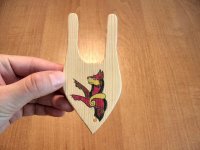
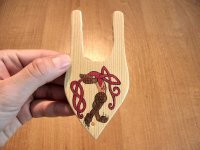
It can be made of wood, thick leather, antler, metal, some say you can use your two fingers but I prefer more stable tool ^^. Lucet cannot be too big - in order to operate it freeley it should fit the palm of your hand. Some lucets have the hole at the bottom where you put the emmerging cord, but it's not necessary, the cord can hang down at the front of a lucet.
You'll also need the skein of yarn - wool, cotton or linnen - you don't have to cut a piece of a yarn but start with the beginning of a skein and then after you reach the desired length - cut it and tie the knot. You'll work with one thread only.
In order to remember that I'll always be turning the lucet to the left, I marked the sides of my lucet with a dog running away from a chasing cat (animals' noses are turned to the left). ^-^
Let's start:
You'll also need the skein of yarn - wool, cotton or linnen - you don't have to cut a piece of a yarn but start with the beginning of a skein and then after you reach the desired length - cut it and tie the knot. You'll work with one thread only.
In order to remember that I'll always be turning the lucet to the left, I marked the sides of my lucet with a dog running away from a chasing cat (animals' noses are turned to the left). ^-^
Let's start:
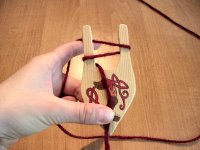
Wind your yarn on the LEFT horn, back to front. Continue winding the yarn on the RIGHT horn, back to front, and once again on the LEFT horn, back to front. Leave the tail of the yarn at the front of the base of the lucet.
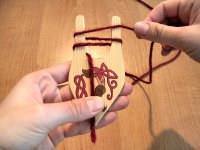
Now bring the yarn across to the front of the right horn.
Turn the lucet clockwise (the painting on the lucet changed from a dog to a grinnning cat! ^^).
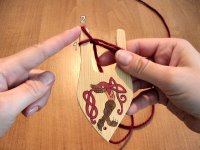
Again lift the lower thread (nr 2) over the upper thread (nr 1) to form the stitch.
Tighten down the stitch, pulling the working yarn gently to the right.
ect., ect...
You will soon notice a nice square cord! ^^.


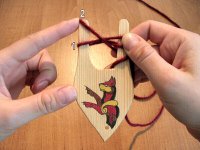




Thanks for a great tutorial!!!
ReplyDeleteThat's really cool, I've never seen that before. Thanks for the tutorial!
ReplyDeleteI saw a Inuit 'neck Pendant' which could have been one of these, with a hole, in a book on the History of Canada. Myself, I have been doing my cordmaking by hand, but will try this method out: TX.
ReplyDelete